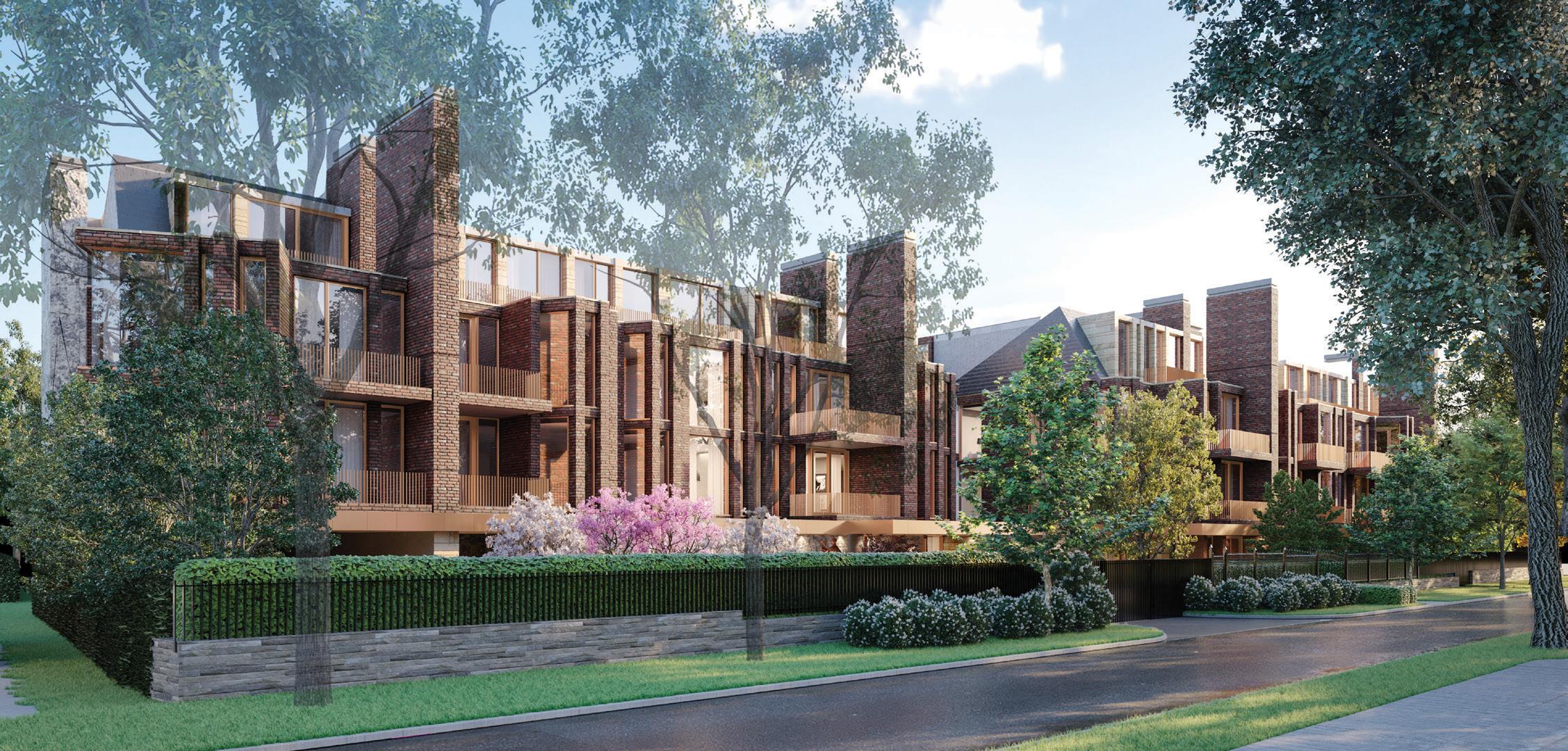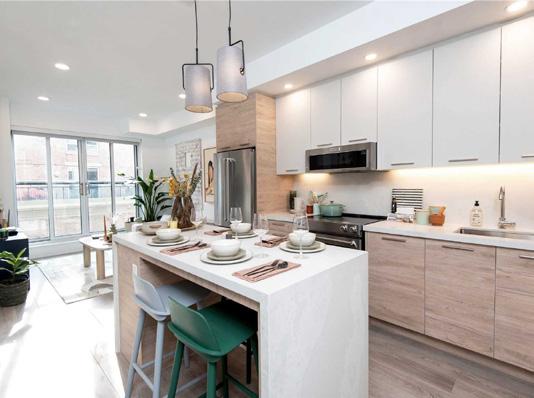
8 minute read
BEE FRIENDLY GARDENS
from The Collection by Harvey Kalles Real Estate Ltd., Brokerage | Summer 2022
by The Collection by Harvey Kalles Real Estate Ltd., Brokerage
How your home garden can help
urban pollinators By Vicki Wojcik and Jordan Phelps

By now, most of us have learned about the plight of pollinators through the reporting of honeybee declines. While the honeybee is undoubtedly important, people are often surprised to learn that it is only one member of the diverse community of pollinating animals on earth. Even among bees, the honeybee is one of over 20,000 species, over 800 of which inhabit Canada in the city and suburbs, just like us. Whether you live in a single-family home, row home, or a condo, in the city centre or near open space, you can help all these bees and other pollinators.
People are also often surprised to learn that the vast majority of the world’s bees live a solitary life, nesting underground or in small cavities, rather than in a bustling social hive. When you think about it further, bees make their homes much in the same way we do. There are some bees that are looking for open space (for them it’s soil or sand), while others prefer the condo lifestyle, looking for holes in wood or other taller vegetation to nest in.
Like us, bees also select their homes to be commuterfriendly and close to food. When we make those choices, we look at homes close to work or near shops and restaurants. A bee’s work is collecting pollen and nectar, and for them that local grocery store or great restaurant is a nice patch of native flowers.
When most of us think of protecting pollinators, supporting honeybees is the first thing that comes to mind. While the honeybee is critical to agriculture, it’s important to acknowledge that it is a domesticated species brought from Europe, and should be thought of as livestock rather than wildlife (cows, sheep, chickens, etc.).

photo by: tiffani harrison photo by: tiffani harrison

Honeybees are not considered to be a threatened species. On the other hand, there are other wild, native pollinator populations that our ecosystems depend upon, facing rapid and widespread declines, largely due to the effects of habitat loss, pesticide exposure, climate change, and disease. In fact, keeping urban honeybee colonies can even exacerbate the stresses faced by our native pollinator populations. If urban honeybee populations get too high, they may overcrowd our native pollinators and reduce food availability.
So, if keeping urban honeybee colonies isn’t the solution to protecting our pollinators, what is? The best thing that we can do to support all pollinators, including native bees and honeybees, is to create habitat. This means planting perennials (plants that grow from year to year), shrubs and trees that provide bees and other pollinators with nectar and pollen — the critical food sources that they need to survive — and providing nesting spaces that solitary bees can call home. We need to build neighbourhoods for bees, just like we do for ourselves.
Here are some simple guidelines that you can use to create your own pollinator-friendly landscape at home:
1 Prioritize plants that are native to your region. They have evolved with native pollinators to provide valuable pollen and nectar resources, and to thrive in your climate without the need for excessive watering and chemical inputs. For plant suggestions, check out Pollinator Partnership Canada’s ecoregional planting guides.
Leafcutter Bee with Goldenrod Bee with Purple Geranium



photo by: kathleen law

2 Incorporate a range of plants that provide food for pollinators from spring to fall. Early Spring and late Fall can be difficult times for pollinators to find blooming plants, despite being critical periods in many pollinators’ lifecycles. For example, many bumble bee species emerge from hibernation in early Spring and produce new queens in late Fall. Aim to have at least three plants blooming all year.
3 Include pollinator host plants. Many pollinators have evolved specialized relationships with particular plant species, and depend on them as a source of food and a place to lay eggs. A well-known example of this is the reliance of monarch butterflies on milkweed.
Avoid insecticides. Insecticides can harm pollinators when touched or ingested through the nectar and pollen of exposed plants. 5 Leave hollow stems and bare soil patches as nesting space. While honeybees live in hives, the vast majority of bee species (>90%) nest underground or in hollow stems.
6 Leave the leaves in your garden over winter. Many pollinating insects lay eggs or hibernate beneath leaves, so removing leaves from the environment can reduce pollinator populations.
7 Provide a water source. Like most animals, pollinators require water. Integrate a water source that allows pollinators to drink without drowning, such as a shallow water dish filled with rocks as landing sites. But what if you live in a condo? While it’s true there is a maximum height that bees will fly for their food, a mid-rise balcony can be a wonderful spot for a bee
Bee with Purple Geranium Carpenter Bee Flying on the Ground


garden. You can pick plants that grow well in containers and follow the same guidelines for home gardeners. And who knows…you might also see bees nesting in the soil of your planter.

You can also engage your Home Owners Association in making sure that the gardens and planters that are landscaping your building are better for the bees. Help get native plants into the gardening plan, and make sure that your building isn’t using harmful insecticides. Work with your HOA on the landscape maintenance plan, and leave some habitat for nesting. By following these guidelines to create pollinator-friendly landscapes at home, you will be making a meaningful difference for all pollinators. Over 85% of flowering plants are animal-pollinated – meaning that most flowering plants on earth rely on pollinators to reproduce. Most of our commonly grown crops also depend on or benefit from pollinators, and this accounts for a third of our diet. So, when we think about making our home a wonderful place to live, let’s think about making a wonderful home for the bees and other pollinators.
Vicki Wojcik is the Director of Pollinator Partnership Canada, a registered charity dedicated to supporting pollinators, plants, and their ecosystems so that we can build a better future. To learn about planting for pollinators, how farming can be more BeeFriendly, or how you can help, visit: www. pollinatorpartnership.ca
Jordan Phelps is the Program Manager at Bee City Canada Program, a program that focuses on helping municipalities make better choices for bees and other pollinators. There are currently 62 Bee Cities in Canada, including many in the GTA, have a look and see if you live in a Bee City: www.beecitycanada.org
photo by: tiffani harrison


#1 #1
IN TRREB C4* AT HARVEY KALLES IN UNITS AND GROSS VOLUME 2020–2021
#3
IN CENTRAL TORONTO**
ADAM WEINER
REALTOR® & FOUNDER OF ADAM WEINER + ASSOCIATES
DIRECT 416.545.9151 WWW.ADAMWEINER.CA WEINER.ADAM


94 CORTLEIGH BLVD $9,800,000 15 BLAINE DR $7,549,000 86 THORNRIDGE DR $6,495,000
91 BROOKE AVE $6,100,000 (EXCLUSIVE)




372 GLENCAIRN AVE $5,595,000 211 CARMICHAEL AVE $4,395,000 64 KILLDEER CRES $4,395,000 35 BURNCREST DR $4,295,000




189 BROOKE AVE $3,179,000 954 KING ST. W #315 $999,999


SOLD 660 EGLINTON AVE $639,900
SOLD THE BRIAR ON AVENUE FROM $3,100,000
SOLD


THE REDPATH LEASES


SOLD 11E TRANBY AVE
SOLD 370 GLENCAIRN AVE 176 COLDSTREAM AVE
SOLD SOLD


42 CHAPLIN CRES


SOLD 235 DELORAINE AVE
SOLD 604 ST. GERMAIN AVE
SOLD 173 STRATHEARN RD
SOLD


183 GLENGARRY AVE 304 ORIOLE PKWY 179 DINNICK CRES 461 WOBURN AVE









